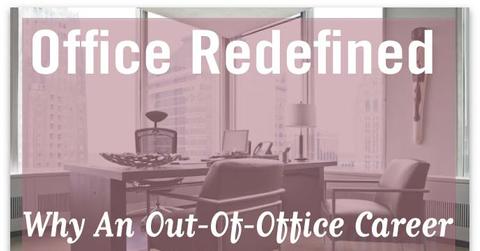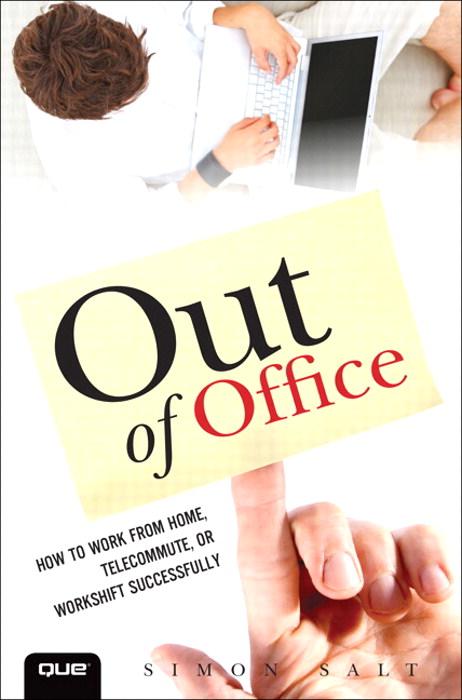Office Redefined: Why an Out-of-Office Career May Be Calling Your Name

My own decorated office on the top floor of some New York skyscraper with an amazing view, like the ones you see in the movies- that’s one of my dreams. Being in an office makes you feel like you’re important, like you’re a somebody.
Currently, as a virtual intern for Her Agenda, I don’t have a set office to work in. I have the freedom to work anywhere I want, whether it’s at home in my pajamas, the public library, or one of my favorite coffee shops. My editor and I have never met in person; we live on complete opposites of the country and communicate solely through phone, email, instant messaging, and video chat. We have our weekly meetings on Mondays in between my two college classes; I wave to her from my school’s cafeteria via Skype. This is an example of today’s “workshifter.”
Workshifting, a website which provides out-of-office workers with the latest telecommuting tools, defines the term as “an updated definition for “telecommuting” and “remote working”, that refers to the ability of being part of a distributed workforce, working from outside of the office and shifting one’s work habits to achieve a better work-life balance.” To get a better idea what this actually means, watch the quick video clip below:
What it comes down to is this- working outside of an office has been a really insightful and fun experience, and I am enjoying it tremendously. It has made me question whether the office setting is really what I want. Now of course, working outside of an office isn’t for everyone; some professions require constant contact with their team, and others simply need the structure of an office setting to stay focused. But what about the rest of us? There must also be people out there who don’t prosper in the 9 to 5 office setting.
Stanford Economics Professor, Nicholas Bloom, worked with James Liang, cofounder of Chinese travel site, Ctrip, to do a nine month study which recorded the productivity of workers both inside and outside of the office. The staff at Ctrip’s call center was asked which of them would like to work from home for nine months. Out of the total number of staff members who volunteered to work from home, half were given permission to telecommute; the rest of them remained in the office. Bloom reports the results of the study:
“We found that people working from home completed 13.5% more calls than the staff in the office did—meaning that Ctrip got almost an extra workday a week out of them. They also quit at half the rate of people in the office—way beyond what we anticipated. And predictably, at-home workers reported much higher job satisfaction.”
You would think that working outside of the office, workers would be less productive without the structure of the office setting. Ctrip believed this to be true, as one of the key reasons they agreed to do the study was only because they thought it would help them to save money on space and furniture. However, the results from the study proved the benefits to be even greater. Bloom reveals his reasoning behind the surprising results:
“One-third of the productivity increase, we think, was due to having a quieter environment, which makes it easier to process calls. At home people don’t experience what we call the “cake in the break room” effect. Offices are actually incredibly distracting places. The other two-thirds can be attributed to the fact that the people at home worked more hours. They started earlier, took shorter breaks, and worked until the end of the day.”
Still not finding these facts convincing? Check out this visual that maps out statistical difference between happy workers and sad workers.

In a new book, Out of Office: How to Work from Home, Telecommute, or Workshift Successfully, Simon Salt shares some of the key reasons why he finds the transition from the traditional workplace to out-of-office living beneficial. Here are four of them:
1. Planning out your own work schedule
“I certainly like to know that I am free to decide when I write a blog post, an article, or a chapter of a book or work on a client project as I feel the pull…Although I have daily targets I always strive to meet, I don’t always write at the same time of the day or in the same location. I find that freedom to be very helpful in the creative process.”
2. Choosing your “office”
“Like a lot of creative people, I find it extremely difficult to create and be inspired while sitting at a desk between the hours of 9 and 5. Heck, those aren’t even the hours I’m most productive…A change in scenery inspires me both in the moment and then again later…”
3. Removing the work from “work”
“If it doesn’t feel like work, then it is likely to be more enjoyable, and happy people are more productive…waking up each day and knowing that your commute is two minutes or less down the hallway, or across the street to a coffee shop, is a lot less daunting than facing a mile-long tailback on the freeway….”
4. Redirecting your energy
“All of the hours that would be spent schlepping to and from work, now goes directly into projects. This reallocation of energy lets me work more effectively and fluidly.”
If this way of work sounds just as appealing to you as it does to me and you’re interested in learning more, pick up Simon Salt’s book here.
Well, now that you know a little bit more about out-of-office work-life, what companies actually offer their employees this type of lifestyle? Here are a few you probably know:
1. Xerox has a “Virtual Workforce Program” that already allows 5,000 employees to ability to work from home
2. Upworthy has gone and reformed the image of the traditional work office- location, work hours, and vacation time- it’s all yours to decide!
3. Aetna offers both home-based and partial home-based job opportunities for their employees, and for those who may be telecommuting for the first time, they even provide training courses to help you start off strong!
4. Dell works with each of its individual employees to ensure that they have a satisfying work-life balance, and they also provide accommodations for working mothers
To learn more other companies that offer out-of-office program, read “100 Top Companies for Remote Jobs in 2014.”
Going back to the image of my dream office, I can slowly see it morphing into something new. The well-decorated office and great view are still there, but it no longer has to be in some big shot sky scraper. I would be just as content within the comfort of my own- a place that I can still call my own.
Whether or not an out-of-office job is for you, your work-life should be shaped around that which you are most productive in. With today’s advancements in technology, the world has become a smaller place, and a more flexible work environment has become possible.





